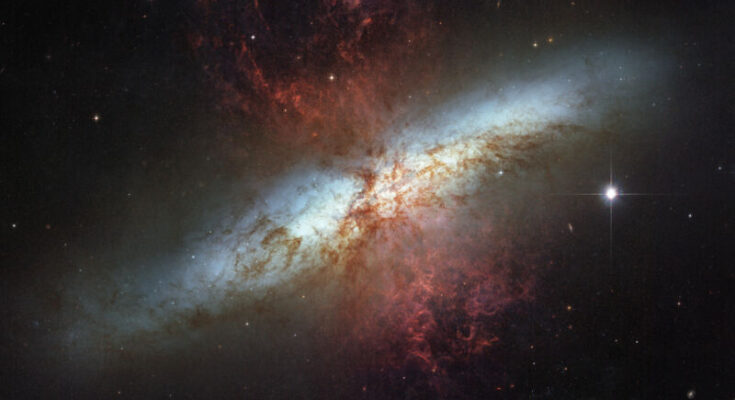NASA, ESA and the Hubble Heritage Group
Gamma rays are a broad group of high-energy photons, including everything with more energy than X-rays. Although they are often created by processes such as radioactive decay, rare astronomical events produce them in large enough quantities that they can be seen when the rays appear in another galaxy.
That said, the list is bigger than one, which means that detecting gamma rays doesn’t mean we know which event produced them. At low energies, they can be produced in the vicinity of black holes and neutron stars. Supernovae can also produce sudden bursts of gamma rays, as can the mergers of compact objects such as neutron stars.
And then there are magnetars. These are neutron stars that, at least temporarily, have an extreme gravity—more than 1012 times stronger than the Sun’s gravity. Magnetars can have flames and even large fires where they emit large amounts of energy, including gamma rays. It can be difficult to distinguish these objects from the gamma-rays produced by mergers, so a large explosion is confirmed to have occurred in our galaxy or its satellites. Until now, it seems.
What was that?
The burst was spotted by ESA’s Integral gamma-ray observatory, among others, in November 2023. GRB 231115A was short, lasting only 50 milliseconds at some wavelengths. Although long bursts of gamma rays can be produced by the formation of black holes during supernovae, these short bursts are similar to those expected to be seen when neutron stars merge.
Guidance data from Integral placed GRB 231115A right above the nearby galaxy, M82, also known as the Cigar Galaxy. M82 is a so-called starburst galaxy, which means that it is forming stars at a rapid rate, with bursts likely caused by interactions with its neighbors. Overall, the galaxy forms stars at a rate more than 10 times faster than the Milky Way. That means more supernovae, but it also means a greater number of small neutron stars, some of which they will form magnetars.
That fact does not rule out the possibility that M82 was sitting in front of a gamma-ray burst from a distant event. However, researchers use two different methods to show that this is unlikely, leaving something else inside the galaxy as the main source of the radiation. gamma.
It could still be a gamma-ray burst in M82, except that the estimated energy of the burst is much lower than we would expect from those events. A supernova should also be seen at other frequencies, but there was no sign of one (and they usually produce long bursts). Another source, the merger of two compact objects such as neutron stars, could have been detected using our gravitational wave telescopes, but there was no visible signal at this time. These events usually leave behind X-ray sources, but no new sources appear in M82.
So, it looks like a large magnetar wave, and none of the possible explanations for the short burst of gamma rays actually work for GRB 231115A.
Looking for more
The exact mechanism by which magnets produce gamma rays is not fully worked out. It is thought to involve a reorganization of the neutron star’s surface, forced by the force produced by the incredibly strong gravitational field. It is assumed that the large gradients require a magnetic field strength of at least 1015 gauss; Earth’s gravity is less than one gauss.
Assuming that the event sent radiation in all directions instead of directing it to Earth, the researchers estimate that the total energy released was 10.45 ergs, which translates to about 1022 megatons of TNT. So, while it is less energetic than merging neutron stars, it is still a very energetic event.
To understand them better, however, we probably need to go three times in our immediate vicinity which is clearly associated with the magnetar. So, being able to regularly determine when these events occur in distant galaxies would be a major breakthrough for astronomers. The results can help us create a template for distinguishing when we are looking at big flares as opposed to other sources of gamma rays.
The researchers also note that this is the second major wave associated with M82, and, as mentioned above, interstellar stars can be expected to be highly magnetized. Focusing on research on it and similar galaxies may be just what we need to reinforce what we see so often.
Nature, 2024. DOI: 10.1038/s41586-024-07285-4 (About DOIs).
#magnetic #field #galaxy






